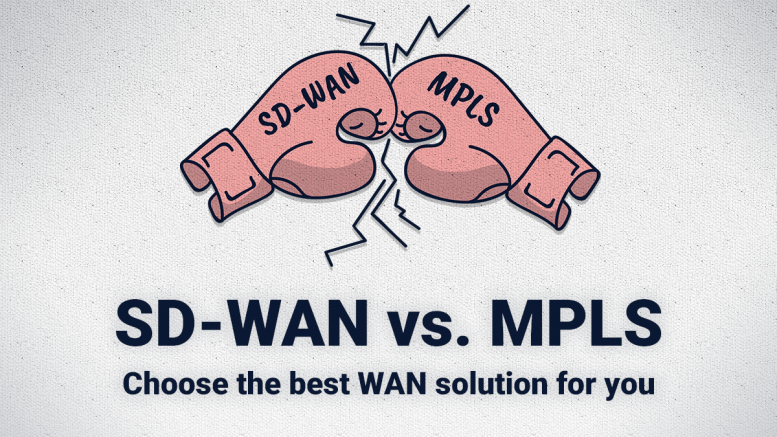Over the last five years or so, the industry has seen a fair amount of debate over which WAN solution is “best”. MPLS (Multiprotocol Label Switching) gained popularity in the early 2000s and gained a strong foothold as the go-to WAN solution for many enterprises. However, as cloud and mobile usage skyrocketed, the inflexibility and high bandwidth costs of MPLS exposed some real issues with the technology. SD-WAN emerged as a compelling alternative to MPLS, and the debate took off.
While SD-WAN was still maturing, there was some merit to the MPLS side of the SD-WAN vs MPLS argument, but we are at a point where, for the majority of use cases, SD-WAN, when done right, clearly outstrips the alternatives. This has led to industry experts like Gartner going as far as to say “SD-WAN is killing MPLS”, and has proven to be particularly true for enterprises with a global presence. The complexities of a global WAN rollout are vast and the converged infrastructure enabled by modern SDWaaS (SD-WAN as a Service) solutions can not only improve WAN performance, but also reduce complexity and time to provision new sites.
In this piece, we’ll dive into some of the unique challenges involved with adding overseas branches to a WAN, discuss how MPLS solutions often fall short, and explain how SDWaaS can help optimize international WAN deployments.
The challenges of adding overseas branches to a WAN
- High costs
Anyone who has been in the business of deploying WANs over the past decade can tell you: MPLS bandwidth isn’t cheap. This statement holds true across the globe, and costs in international deployments can significantly increase the costs of onboarding a new remote site (for example as a result of mergers and acquisitions or opening of a new branch). However, the bandwidth costs are only part of the story. The cost of management and maintenance of legacy solutions like MPLS create recurring costs that have further negative impact on ROI.
- Poor cloud compatibility
One of the fundamental problems with MPLS is its lack of flexibility and compatibility with cloud workloads (e.g. Office 365, G-Suite, Jira, Confluence, etc.). Oftentimes, enterprises using a WAN built solely upon MPLS must backhaul Internet-bound traffic to a given corporate datacenter or headquarters for auditing and security purposes before then sending it on to its destination somewhere on the public Internet. This process then occurs in reverse when a response is received back from the cloud. This inefficient backhauling creates what is commonly known as the trombone routing problem. Further, not only does this backhauling degrade WAN performance a bit, it entails paying for bandwidth twice (once over the MPLS connection, and again to send the traffic over the public Internet).
- Complex & time-consuming provisioning
In many cases, getting a new overseas site up and running as soon as possible is of the highest priority. The faster a site is connected, the faster it can become productive. However, MPLS deployments are often measured in weeks/months due to lead times, complexity, and provider issues while comparable SDWaaS deployments are measured in days.
Additionally, MPLS solutions often lack the full network security stack required to keep data on the WAN safe (in the cloud-era, the isolated nature of MPLS doesn’t cut it), meaning additional security products and appliances must be sourced, provisioned, and maintained to get the WAN up and running.
How SDWaaS makes adding overseas branches easier
- Affordable costs
Premium cloud-based SDWaaS allows users to leverage affordable public Internet bandwidth, which provide a significant cost savings over MPLS. Additionally, the fact that security and management are baked into premium SDWaaS significantly lower the complexity involved with adding new overseas branches and eliminates the need to purchase variety of 3rd party security and management tools.
- A converged experience
As premium SDWaaS includes a robust SLA-backed global backbone, it is able to offer a number of benefits other overseas WAN solutions cannot. With multiple Points of Presence (PoPs) across the globe, support from Tier-1 ISPs (Internet Service Providers), and shared datacenter space with major cloud service providers like AWS, Azure, Office 365, and Jira, SDWaaS brings seamless cloud computing performance to international offices across the globe.
- Simple management & fast provisioning
As previously mentioned, with SDWaaS going from the planning stages of an overseas branch deployment to the “done” stage is significantly faster with SDWaaS. This is because SDWaaS offers simple management interfaces, eliminates the need for many complex appliances because of its built-in full network security stack, and zero-touch features. To conceptualize the ease of working with SDWaaS, consider the fact that a VPN connection can be setup and working in the field in less than ten minutes (try and beat that with VPN appliances!).
When it comes to international WAN deployments, SDWaaS is the clear winner
As we have seen, deploying and maintaining a multinational WAN is no easy task. The inherent complexities of WAN management are compounded by venturing into multiple different nations and legacy WAN like MPLS solutions fall short when it comes to this use case. Fortunately, SDWaaS is able to provide enterprise with a converged, affordable, and scalable WAN solution across the globe. Organizations that fail to make the transition to SDWaaS soon will continue to waste time and resources on MPLS that could be better allocated to core business functions.



Be the first to comment on "SD-WAN vs. MPLS: Why Enterprise WANs Adding Overseas Branches Can No Longer Remain on the Fence"